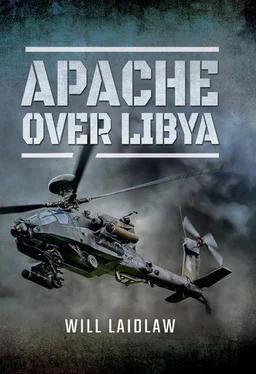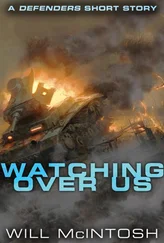‘Just your last target to go.’
Nick: ‘Yes… left it after the first run in. You still want me to have a go?’
‘Yes, I’ll watch you in. I have you visual.’
‘Wilco.’
In went a November Hellfire, and the storage container separated into millions of pieces as the ammunition inside went off. The explosion was enormous! The sound, after the initial Hellfire strikes and the Paveways, must have been incredible and heard, with the other strikes, all the way across the front line, giving heart to the rebels and the fear to 32 Brigade.
‘That’s the one!’
Nick: ‘Yep, that’ll do it!’
‘All good, returning to Mother.’
The total mission time was 45 minutes. We’d fired six Hellfire and observed the Paveway IVs take down their targets from way up at 25,000ft; and all that was heard between the explosions was the rhythmic thunder of our rotor-blades. Simple, safe enough, hard-hitting and back on deck in less than an hour. No missions were planned for the next few days. This deserved a beer.
In four missions a pair of Apaches had flown just twelve hours and fired twenty-seven Hellfire. We’d struck targets across the full depth of Khamis Gaddafi’s outfit and inflicted irrecoverable damage to his capability. We’d done so alongside HMS Liverpool and in concert with Typhoon and Tornado. And, of course, there were also several thousand Free Libyans on the ground doing the hard fighting. This combination of platforms and weapons created more problems than Khamis could deal with, left huge holes in his front line and saw the rebels begin to advance.
Back on Ocean we were in good spirits; it had been a very successful week. I wondered, privately, what it would take to get this operation completed. Brega was key, so was Zlitan, but the biggest prize was Tripoli. Only the rebels could make the difference on the ground, but with such a large and sustained aerial effort from NATO, it seemed to me that the tipping point was coming. The stalemate of April, May and June would give way in favour of the rebels and the newly recognized National Transitional Council (NTC), and the race for Tripoli would begin. While pacing the flip-flop or the Operations Room I kept my mind on the tactical detail of how we might be part of that, but in the wardroom we all discussed what forces would be unleashed in the final reckoning and how Gaddafi himself might try to defend his last bastion. A protracted urban battle with huge loss of life, displaced persons, destroyed infrastructure and arrested state functionality has no winner. In such a scenario the state is ruined from the inside out as the dictator clings to power and robs what he can from the remains. At the same time, the fighters tear each other apart to gain irrelevant advantage, and in every street and under all the rubble lie the civilian victims who had no choice but to stay and watch the whole shameful disaster unfold. This is what NATO sought to avoid in Benghazi when the jets first flew in late March. Keeping Tripoli from a similar fate must have been in their minds now.
There was talk of Gaddafi being given refuge in Venezuela, but also of his determination to remain in Libya. The NTC appeared keen to kill or capture him and his sons and inner circle. This made a fight-to-the-last-man scenario more likely. But perhaps if the rebels could gain the advantage in Brega, Zlitan and the Nafusa mountains to the south of Tripoli, all at the same time, then the tipping point might arrive sooner. The rebels could then advance across all three fronts. [9] Apache missions were launched in all three front lines in Libya (Brega, Zlitan and Nafusa), with our final missions taking place in the Nafusa mountains
Gaddafi would not be able to contain them. Defections and desertions would increase. No one would be available to defend Tripoli. Those who could do so would take off their uniforms and leave their posts. Conscripts would run back to their families. Support for Gaddafi out of fear of his internal intelligence apparatus would disappear. Libyans could stand up for themselves in ever greater numbers as they calculated that the security forces of the state would not reach them. This was the scenario NATO needed. On the telly, the usual talking heads peddled their expertise – some spoke of the stalemate continuing for another six months, others said this thing could go big pretty soon. In HMS Ocean we wanted a little bit more, but not too much. We felt we were winning our own small battle but we were also very alert to the dangers we faced, and those weren’t going away. By 3 August we had been at sea for 100 days. So much for a six-week exercise!
Chapter 11
The Rebel in the Mountains
With combat in Brega and Zlitan we had fought on two of the three Libyan front lines. The third appeared too far inland to risk helicopters. Keeping to the coastal options kept the decision men happy: short missions with minimum vulnerable time. But the taking of risk is about the balance of reward, and we were constantly analysing this risk-and-reward calculation. The layering of jets and drones and the timeliness of target fidelity were all part of trimming away that risk, real or otherwise.
The easiest thing to do was not fly at all. This would keep Gaddafi guessing, but without action was ultimately toothless. If we had to fly, the safest way was to remain feet-wet over the sea and launch Hellfire from as far away as possible to remain outside the triple-A and MANPAD range. But this required targets right on the coast, almost on the beach. Beach fighting was not big in Libya, so we had to go inland. This was where we entertained the most risk. But getting tangled up with the best of 32 Brigade and coming out on top had proved we could operate inland and that the cautious approach to risk could be reconsidered.
Intelligence assessments made a long way from us that shaped planning ideas in NATO had begun to point to the third front, the Nafusa mountains. Here the same stalemate existed as everywhere else. When intelligence is presented to the front-line combat operator, he can question it, he can ask where it came from and he can try and analyse it himself. None of this is ever met with anything other than a patient stare from the Intelligence Officer. The work is done. The information has been gathered, considered, analysed and distilled into options. These options are then considered by the decision men, and a plan is made. The plan is then given to the combat operator. We are expected to get on with it; the asking questions part is not in our gift. Our part was in providing a plan that satisfied the risk warriors, then manning up, guns and night sky, and charging again into the barrage. And now intelligence suggested that the third front would break out first. It was closest to Tripoli but it needed a catalyst, and helicopters could help.
The analysis was clear: Colonel El-Moktar Firnana, the rebel commander south-west of Tripoli, wanted more from NATO. He wanted to unlock the third front line as the quickest and most likely route to Tripoli. Intelligence analysts had asserted only the previous month that the rebels in the mountains would remain there. They were tribal, it was their home, they had won it back and they had no interest in advancing on Tripoli. Now that view had changed completely.
Talk of a deep strike into the mountains began in early July, but these were just exploratory discussions. We were used to coastal strikes, and the Brega raid had made the CAOC apprehensive about sending us a long way overland. But the information kept coming in. During a slow off-mission day in a quiet flip-flop, with most crews in rest or flying maintenance sorties, the Commodore’s Intelligence Officer bundled down the chain ladder and pointed at Nick.
Читать дальше












